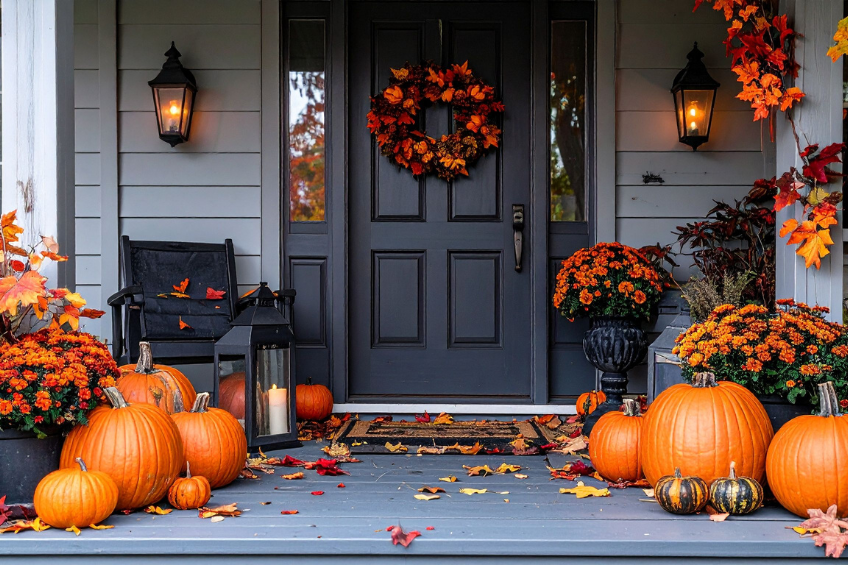Embracing Autumn While Protecting Your Home
New England’s fall season brings stunning foliage, crisp air, and cozy evenings by the fireplace. But between those picture-perfect moments, autumn also delivers unpredictable weather swings, from unseasonably warm days to sudden freezes, not to mention those famous nor’easters that can arrive before Halloween. Let’s walk through practical steps to prepare your home for whatever fall throws our way.
Exterior Maintenance Before Winter Arrives
Gutter and Downspout Care
Those beautiful falling leaves quickly become gutter-clogging problems. Clean gutters thoroughly after most leaves have fallen but before the first freeze. Check that downspouts direct water at least 3-5 feet away from your foundation. Consider installing gutter guards if you’re tired of this annual chore – your future self will thank you.
While you’re up there, inspect your roof for damaged or missing shingles. Fall’s strong winds can turn small issues into major problems, especially when followed by snow and ice.
Foundation and Grading Check
Walk around your home’s perimeter, looking for cracks in the foundation or areas where the soil has settled away from it. Fall’s freeze-thaw cycles can worsen existing cracks, allowing water infiltration. Fill small cracks with appropriate sealant and ensure soil slopes away from your home.
Heating System Preparation
Furnace Tune-Up Time
Don’t wait for the first cold snap to discover your heating system needs attention. Schedule professional maintenance now while technicians aren’t swamped with emergency calls. Change filters monthly during heating season – clean filters improve efficiency and air quality.
Test your thermostat by running through heating cycles. If you’re still using an old manual thermostat, consider upgrading to a programmable or smart model. The energy savings typically pay for the upgrade within one to two years.
Chimney and Fireplace Safety
If you have a wood-burning fireplace, schedule chimney cleaning and inspection before lighting that first cozy fire. Creosote buildup is a serious fire hazard. Stock up on seasoned firewood now – properly dried wood burns cleaner and provides more heat.
Check chimney caps and screens to ensure they’re secure and intact. These prevent animals from nesting in your chimney and reduce downdrafts during storms.
Weatherproofing and Insulation
Window and Door Sealing
Feel around windows and doors for drafts. Replace worn weatherstripping and apply caulk to gaps. For older windows, consider installing storm windows or applying insulating film to improve energy efficiency. These simple steps can reduce heating costs by 10-20%.
Don’t forget about your attic access door or pull-down stairs. These are often significant sources of heat loss. Add weatherstripping and consider an insulated cover.
Attic and Insulation Inspection
While checking the attic, look for signs of animal intrusion, water damage, or inadequate insulation. In New England, attics should have at least R-38 to R-60 insulation. If you can see the ceiling joists, you probably need more insulation.
Outdoor Equipment and Landscaping
Lawn and Garden Preparation
Give your lawn a final mow, cutting it slightly shorter than usual to prevent snow mold. Rake leaves regularly – wet leaves can suffocate grass and become slippery hazards. Consider mulching leaves with a mower instead of bagging them; they’re excellent natural fertilizer.
Winterize your irrigation system before the first hard freeze. Drain and store garden hoses, and insulate outdoor faucets with foam covers.
Tree and Shrub Maintenance
Trim dead branches and those hanging over your roof or power lines. Fall is ideal for this work – you can see the tree structure clearly, and cuts heal before spring growth. However, leave major tree work to certified arborists, especially near power lines.
Emergency Preparedness
Storm Supply Check
New England fall storms can bring power outages. Check your emergency supplies:
- Flashlights and fresh batteries
- Battery-powered radio
- First aid kit
- Non-perishable food and water (3 days’ worth)
- Medications
- Portable phone chargers
Test your generator if you have one, and stock up on fuel. Know how to operate it safely – never run generators in enclosed spaces.
Carbon Monoxide and Smoke Detectors
Replace batteries in all detectors when we “fall back” for Daylight Saving Time. Test each detector monthly and replace units older than 10 years. With homes sealed tight and heating systems running, working CO detectors are essential.
Planning Ahead
Create a fall maintenance schedule that works for your lifestyle. Spreading tasks over several weekends makes them less overwhelming. Keep a home maintenance journal, noting when tasks were completed and any issues discovered.
Remember, fall preparation isn’t just about preventing problems – it’s about creating a comfortable, efficient home for the months ahead. Taking action now means you can relax and enjoy the season’s beauty instead of scrambling when the weather turns harsh.


